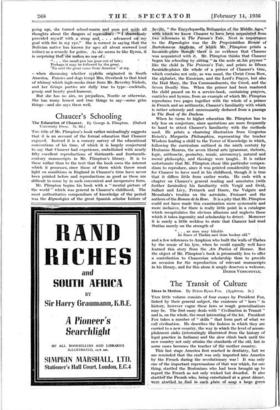Chaucer ' s Schooling THE title of Mr. Plimpton's book rather misleadingly
suggests that it is an account -of the formal education that Chaucer enjoyed. Instead it is a cursory survey of the educational conventions of his time, of which it is largely conjectural to say that Chaucer had experience, embellished with nearly fifty excellent reproductions of thirteenth- and fourteenth- century century manuscripts in Mr. Plimpton's library. It is to these rather than to the text that the book owes the interest which it possesses, since those of them which throw most light on conditions in England in Chaucer's time have never been printed before and reproductions as good as these, are difficult to come by in such convenient and inexpensive form. Mr. Plimpton begins his book with a " mental picture of the world " which was general in Chaucer's childhood. The most authoritative compendium of knowledge of the period was the Etymologies of the great Spanish scholar Isidore of `! the 11.CY.elnpaedia., Blitannica_ofjhe MiskileAges," Witli-'100gh-know-!el..197.:Cha0er: kcilf4140. from 4Wirieterences in The Parson's Tale. Next in impittance to the Etymologies was the De propriefritibus Rerneri of „Bartolometra Anglicus, of 71.rhf.eh Mi. Plimpton prints a facsimile-plate thdughrtheri is no evidence that (*sneer was acquainted with it. Mr. Plimpton thinks that Chaucer began his schooling by sitting." the: scole.at:Iria prymer " -like the child in The Prioress's Tale, and prints in fifteen ifacsirhile,plates the whole• of a primer of Chaucer's time,
- which contains not only, as was usual, the Christ Cross Row,
the alphabet; the -Exorcism,-and the Lord's Prayer, but also the Hail Mary, the Ten Commandments, the Creed, and the Seven Deadly Sins. When the primer had been mastered the child passed on. to a service-book, containing prayers, canticles and hymns, from an example of which Mr. Plimpton reproduces two pages together with the whole of a primer in French and an arithmetic, Chaucer's familiarity with -which is rather solemnly and unnecessarily deduced from a passage in The Book of the Duchess. When he turns to higher education Mr. Plimpton has to rely less on conjecture, since quotations are more frequently to hand to attest Chaucer's familiarity with the methods used. He prints a charming illustration from Gregorius Reisch's Margarita Philosophica, representing the teacher Wisdom leading a child to the Tower of Knowledge in which, following the curriculum outlined in the ninth century by Hrabanus Maurus, the seven liberal arts (grammar, rhetoric, logic, arithmetic, geoinetry, Music; aStronomy), natural. and moral philosophy, and theology were taught.. It is rather unfortunate that Mi. Plimpton chose this particular compen- dium to reproduce, since it was printed considerably too late for Chaucer to have used in his childhood, though, it is true that it differs little from earlier works. He ends with a chapter on Chaucer's general reading and annotates .(with further facsimiles) his familiarity with Vergil and -Chid, Sallust and Livy, Petrarch and Dante, the Vulgate and Messahala's treatise on the astrolabe, Froissart and the authors of the Roman de-la Rose. It is a pity that Mr. Plimpton could not have made this examination more systematic-and more inclusive, for there is really little point in a catalogue which recapitulates the obvious allusions and neglects those which it takes ingenuity and scholarship to detect. Moreover it is surely a little reckless to state that Chaucer had tead Statius merely on the strength of " . . . as men may biholde In Stace of Thebes and thise bookes old." and a few references to Amphion who built the walls of Thebes by the music of hislyre, when he could equally well' have learned this story his_ the Ars Poetica of Horace. But the object of Mr. Plimpton's book is. presumably less to Offer a contribution to Chaueerian scholarship than to provide an occasion for the reproduction of relevant manuscripts in his library, and for this alone it amply deserves a welcome.
DEREK VERSCROYLE,














































 Previous page
Previous page